The Beautiful Trap: Janine Antoni’s Body Art
Introduction
When Janine Antoni performed Loving Care in 1993, she moved herself into the history of contemporary art, and she has occupied that place ever since. Like any negotiation with history, the understanding of her performance, in which she dipped her long hair in black dye and set about mopping the floor, has been complicated by its initial reception. Loving Care is famous because of a series of black and white photographs documenting the event that recalls the photographs Hans Namuth took of Jackson Pollock working on an Abstract Expressionist canvas. The association is apt; as a woman artist Antoni was mimicking the making of an action painting and claiming a piece of the territory that had been occupied primarily by male artists. (She was also referencing Yves Klein’s use of his models as paintbrushes with the transformative difference that in her enactment she was both model and master). But what the Loving Care photographs don’t show is that she was also driving out of the performance space the crowd that had gathered to watch a woman, in a vulnerable position, enacting a laborious and inexplicable ritual. Like so much of her subsequent work, Loving Care was simultaneously about being in danger and being defiant. It was a piece that did double duty.
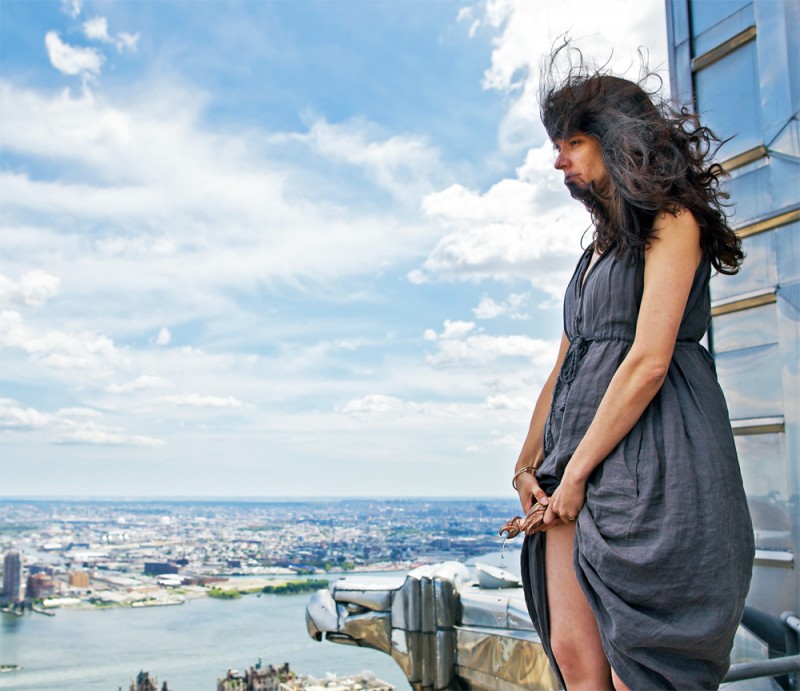
Conduit, 2009, copper sculpture with urine verdigris patina, framed digital c-print. Image size 28 x 33”. Sculpture: 2 x 7-1/4 x 2-1/4”. Courtesy of the artist and Luhring Augustine, New York.
From the beginning, Antoni has used her body as the object through which she has measured her place in the world. She has said that her body “is a funnel through which the world is poured,” and for the last 20 years she has discovered subtle ways to effect that pouring. Early works, like Gnaw, 1992, and Lick and Lather, 1993, were inspired sculptures that were at once objects and processes that engaged important trajectories in contemporary art. In Gnaw, Antoni chewed away at two 600-pound blocks of chocolate and lard, an act of literal consumption that was also the ingestion and re-formation of the minimalist cube. Here came the Janine; there went the Judd. She completed the piece by melting down the gnawed chocolate into 40 heart-shaped candy packages, and mixed the lard with pigment and beeswax to make 150 lipstick containers, which were then exhibited in a display case. Gnaw was a multi-tasker; it touched on consumer culture, the cult of beauty and art history, all neatly packaged in a single installation. Antoni refers to it as “a mouth-made ready-made.” Her logic in this early work was simple: if her mouth was the hammer and chisel in Gnaw, then in Loving Care her hair could be a paintbrush.
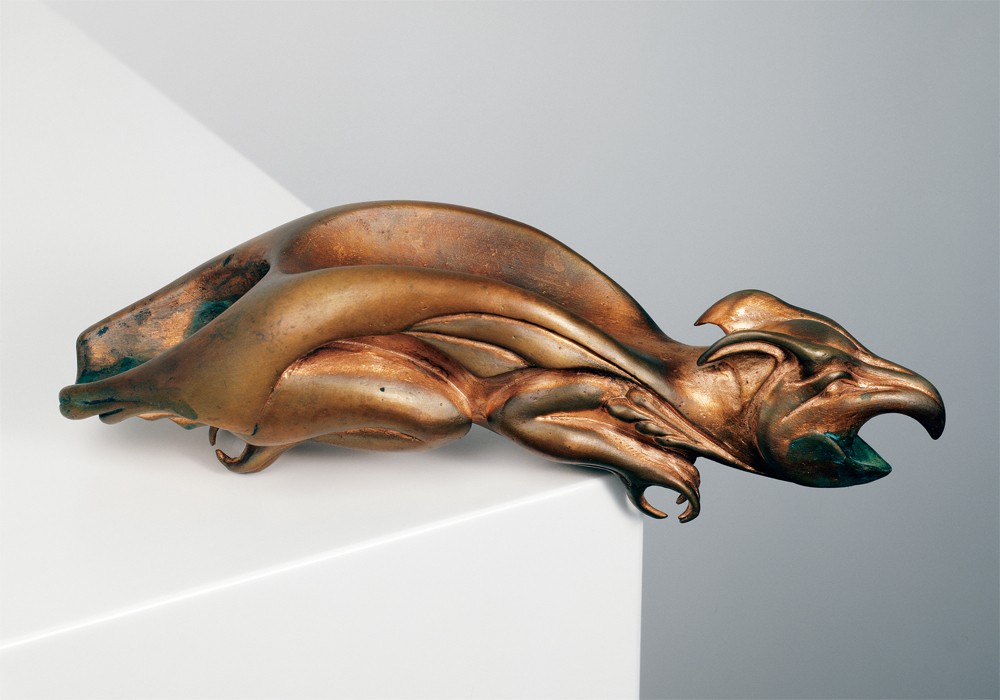
Conduit, 2009, copper sculpture with urine verdigris patina, framed digital c-print. Image size 28 x 33”. Sculpture: 2 x 7-1/4 x 2-1/4”. Courtesy of the artist and Luhring Augustine, New York.
Lick and Lather also took its lead from art history. On two rows of facing pedestals, Antoni arranged 14 self-portrait busts, seven in chocolate and seven in soap. Each of the sculptures had undergone different degrees of defacement; the artist had cast herself and was in the process of licking and washing herself away. The installation was at once historical and contemporary; it was embodied in the tradition of classical self-portraiture and was body art for the late twentieth century. More than any artist of her generation (she was born in 1964), Antoni has fashioned from her own body and its intimacies an art of visceral delicacy. Her tools and her processes are uncommon, from tightrope walking to steam shovels, from using her teeth as a carving tool to re-casting silver in the form of the inside of her mouth. But the effect of the materials she uses, and what she does with them, resonates in her audience like memory and blood.
Motherhood is the larger story that connects the work in “Up Against” to her earlier production. The first piece she made after graduating from Yale in 1989 was a set of negative wall imprints of her breast and nipple. Called Wean, 1990, it drew attention to her interest in finding ways to represent the various stages of separation from her own mother, and to articulate that relationship through a form of absence. The thing not there was the thing most present. “All my objects mediate our intimate interaction with our bodies,” Antoni says, “or they are objects that replace the body, or that somehow define the body within the culture.”
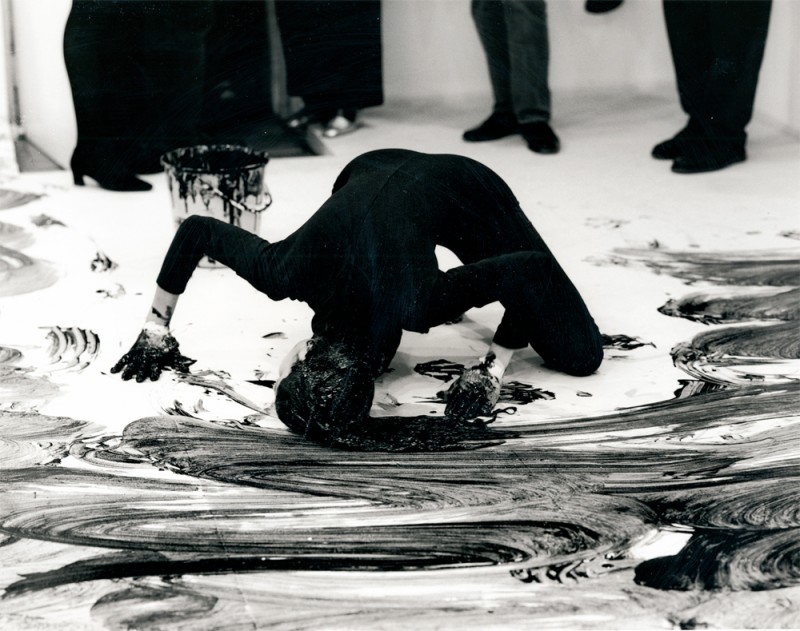
Loving care, 1993, performancing with Loving Care hair dye Natural Black, dimensions vaiable. Photographed by Prudence Cumming Associates at Anthony d’Offay Gallery, London, 1993. Courtesy of the artist and Luhring Augustine, New York.
Her engagement with the ambiguities of mothering continued in works like Momme, 1995, Coddle, 1999, and even in 2038, a colour photograph in which the artist, naked in a bathtub, seems to be nursing the cow whose number gives the image its name. 2038 is a strangely moving variation on the theme of the pieta. Inhabit, 2009, the most dramatic of the photographs in “Up Against,” her exhibition at Luhring Augustine in fall, 2009, shows the artist suspended by a harness, while her body is enclosed in a dollhouse that contains miniaturized objects that are consistent with the style of her real house. A spider has taken up residency in the kitchen and has attached its web to a bowl of fruit on one side and to a wall on the other. Antoni’s suspension is, itself, ambiguous. It’s not entirely clear whether we should regard her as the weaver of her own suspending web, or as a victim caught in the filaments of its harness strings. The double read is an inescapable response. Antoni is aware that she is inhabiting an in-between space, one that sits, as she described it, “somewhere between being suspended and ascending and either entrapped or inside the structure of support, which to me is motherhood.”
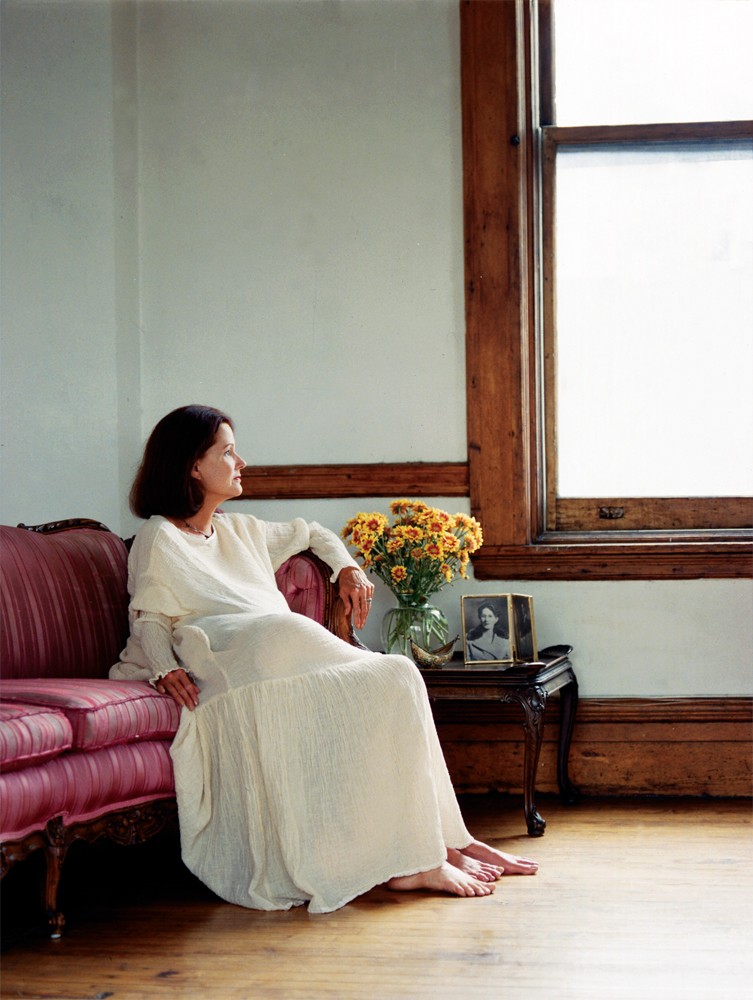
Momme, 1995, c-print, 36 x 29”. Coutesy of the artist and Luhring Augustine, New York.
She keeps returning to the doubleness of things; nowhere is that more evident than in Tear, the piece that dominated “Up Against.” Part of the piece took the form of a two-and-a-half ton wrecking ball, an object we invariably associate with destruction and violence. But Antoni’s wrecking ball was made of lead, so that every time it struck the building it was knocking down, it was suffering damage. Embedded in its surface were fragments broken from another surface. That inescapable condition of being alive–that we visit damage on others and damage visits us in turn–may well be the cause of the tear in the magnificent eye that occupied the gallery for two months last fall.
The following interview was conducted in Janine Antoni’s studio in Brooklyn in October 2009. It was both a conversation and a show-and-tell, as Antoni brought a collection of props, pictures, objects and images for us to better understand the meaning and making of her captivating art.
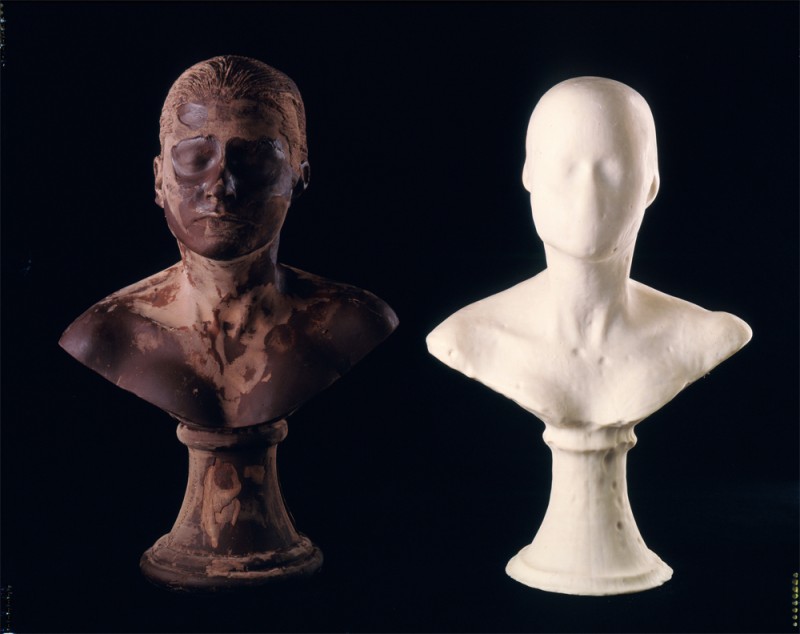
Lick and Lather, 1993, two self-portrait busts: one chocolate and one soap, 24 x 16 x 13”. Photographed by John Bessler. Coutesy of the artist and Luhring Augustine, New York.
Border Crossings: You tend to ask yourself questions when you work, like what is the material of dreams? In your latest work what questions did you pose?
Janine Antoni: What were the questions? What does it mean to both hold space and get out of the way at the same time? And then there were the more specific questions, such as with Conduit, which includes an apparatus that allows a woman to pee standing up, I asked myself if I’m going to pee through an object, what material should it be made of? I was thinking about Duchamp’s Fountain, of course, and so I first made it in porcelain. Then I came to copper. It would patina when in contact with my urine and it calls to mind the decorative cornices on buildings. I started to consider Gothic architecture as the background for my action.
Because of the gargoyle?
Yes, and the copper seemed to bring it all together. But I think I should tell you the story of the artworks from the show, and then the questions will come. One Another came first.

Inhabit, 1009, digital c-print, 116-1/2 x 72”. Coutesy of the artist and Luhring Augustine, New York.
That’s the digital c-print of your midsection and a child?
Right. The gesture in this photograph first happened when Indra was learning to feed herself. She has always been completely fixated on my belly button. Psychologists talk a lot about transitional objects and my belly button was her transitional object. However, it isn’t a true transitional object because she replaced my breasts with my belly button, as opposed to a teddy bear or a blanket. Even now, at five, she still likes to sleep with her finger in it. If she falls down, she wants to put her finger there for comfort, like a security blanket. She calls my belly her belly. “Give me my belly,” she says.
The separation clearly hasn’t happened yet.
Right. One time when I was feeding her she wanted to feed my belly button. I was struck by the spirit of reciprocity in her gesture. There was something about it that was very touching. Also, she was making my work. I can’t claim that piece. Somehow she becomes the mother and her gesture, like an umbilical cord, turns me into a fetus. Certainly having a child has made me grateful to my own mother because you don’t know what it takes until you do it. At the time, I was reading the psychologist D W Winnnicott, who said that mothering your child is an opportunity to re-mother yourself. His is the notion of the good enough mother, which I’m really interested in. I had an opportunity to work with a home for the elderly, and I decided I was going to interview all the women there and ask them if they had any advice on how to be a good mother. There was this one woman who said, “Get out of the way.” Her words still ring in my mind. Once the child isn’t hurting herself or anyone else, you have to trust the process to unfold naturally and in its own time.
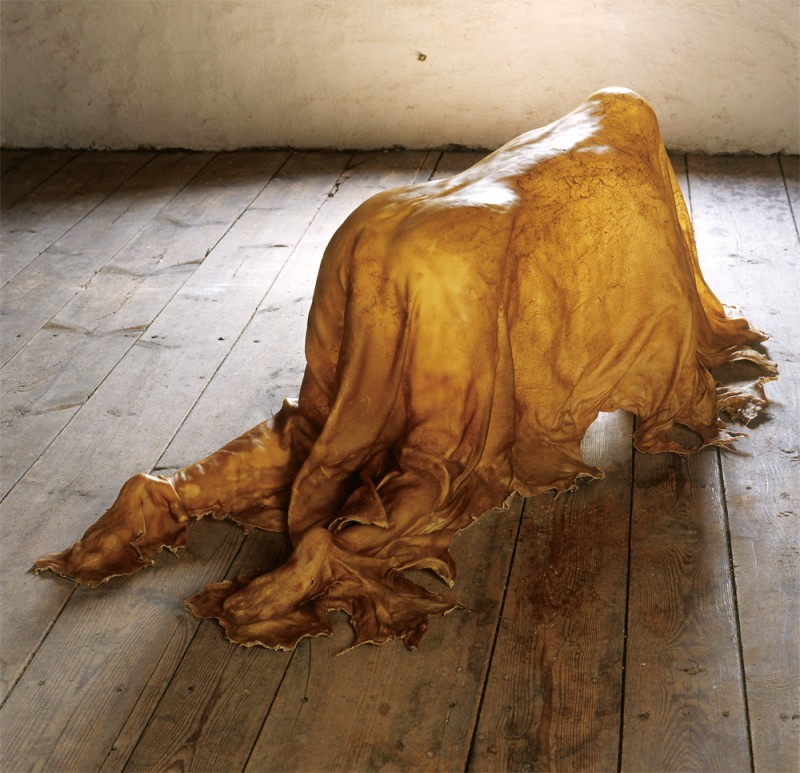
Saddle, 2000, full rawhide, 27 x 32 x 79”. Coutesy of the artist and Luhring Augustine, New York.
What about the gargoyle form of Conduit?
When I was a little girl, my brother was reading a book about pirates and it mentioned Anne Bonnet. She was a woman pirate who disguised herself as a man. What I remember is that she was able to get away with it because she had an apparatus for peeing while standing up. Around the same time, my brother used to tell me about the joys of peeing from high places. My mom told me that when my brother was young they were by the pool at a Holiday Inn, and he walked to the end of the diving board and peed. My mother, who is very proper, was so horrified that she pretended he wasn’t her son. A few years ago a friend told me she’d found this thing on the market called a Travel Mate. It can be used so you don’t have to sit on the toilet seat. When I saw it I thought, “There’s some potential here.” Believe it or not, there are other designs like the WhizBiz or the Shewee, but I modelled the gargoyle using the Travel Mate as its inner core. I then made a photograph of me actually using it.
Gargoyle because you were thinking Gothic building?
Well, this is the leap. The nuns at Catholic school used to tell us that our body was a temple. I have a problem with taking metaphors literally. So I took it to heart, not the way the nuns meant it, which is that your body is sacred, but that my body could be a temple. In Catholicism there is the idea that the Virgin is the church. I thought if I used this gargoyle then I could be a temple or a building. I approached a few churches with the idea and you can imagine the answer I got. “You want to what!?” Instead, I started to consider skyscrapers and Gothic buildings and began to look for other Gothic buildings that I might use to create this image. It’s hard to get access because no one wants you on their roof, so I got turned down a lot. Then a patron of the arts who happens to have access to the Chrysler Building made it happen for me.
ºInitially, I was going for a very different image. I wasn’t going to have my face in it. I was just going to have my body, the gargoyle, the peeing and the landscape. The photographer and I were on platforms to get me at the right height. A professional window cleaner harnessed us up, so what you don’t see is that I have a harness that goes under my dress. I was very cavalier because I’m a tightrope walker and have good balance. I thought it will be great to be so high, but when I actually got out there, the wind was terrifying. It was fine when I was on one side of the building because the gusts were throwing me into the building, but on the other side they were pushing me away from it. There was one moment when the wind was so strong I went down to my knees. After that I was scared to stand on the side of the building. Fortunately, we had the image by then. It is strange that in the end I got access to the Chrysler Building because its bird is not so different from my bird, although I made Conduit long before I knew where I was going to take the photograph. I got to live out all the fantasies I rolled into this work. The wind blew my hair into a beard and that opened up a whole new set of readings. For one, I became part pirate or lion. The griffin is itself a hybrid of a lion and a bird. I also became half man and half woman.
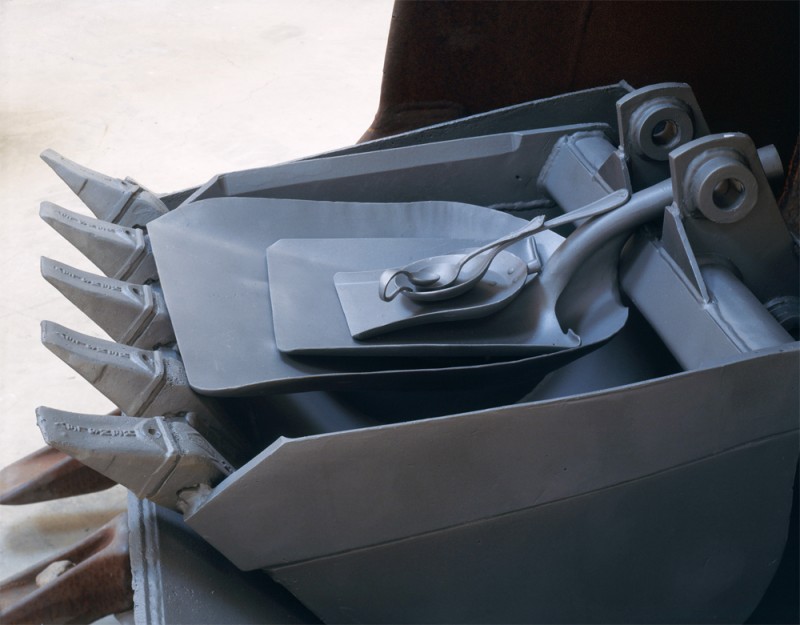
Cradle, 1999, detail, two tons of steel, 59 x 58 x 60-1/2”. Coutesy of the artist and Luhring Augustine, New York.
Those serendipities often happen to you. The connections get made afterwards rather than being intentional.
It depends on what you mean by intentional. I would say that I start with setting an intention and then pay close attention to what is happening. I think the serendipities have somehow always been there, but it’s only now that I can be flexible enough, and take them seriously enough, to have them guide me. We only had one day to get the photo; we were trying to compose an image before we got up on the Chrysler Building. We spent several days using Photoshop to superimpose images of me onto pictures taken from the building. In my old way of working, I would have been so set on what I concluded from those mock-ups that I wouldn’t have noticed this crazy thing that happened with my hair. I think this shift in my creative process has arisen because of my daughter. As a mother, you have to be flexible, spontaneous and responsive in the moment. Nothing is predictable.
To continue reading Border Crossings’ interview with Janine Antoni, order Issue 113 here

